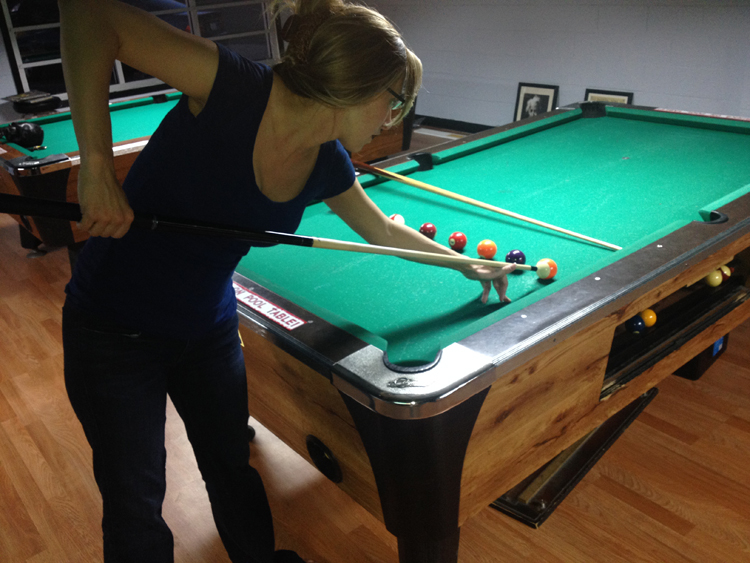Jumping - It’s In The Wrist
As a pool instructor the topic of jumping almost always comes up. For some students it’s the appeal of the trick shot while others simply want to know why many pool halls and bars prohibit jumping. This article attempts to address some common questions I get from students on this topic.
What is jumping? Jumping just means elevating the ball over another ball. It’s an alternative to kicking or masse.
Why jump? As with any shot in pool, there are risks and benefits. In the case of jumping, its low probability should make it a last resort. If there is a better option, use it. When deciding on the jump shot ask yourself: Is there enough landing area so I’m not risking the ball flying off the table? Is there a kick option available? Could a masse shot work here?
Why do some bars and pool halls prohibit jumping? The main reason you see signs in poolrooms about jumping is that most casual players don’t do it correctly. Uninformed players will scoop the ball or attempt to hit the ball lower, striking it on the ferrule and not the tip.
Will I tear the cloth? It’s almost impossible if you do it legally. However, the fear of tearing the cloth looms as a concern about jumping for many players. Don’t worry about tearing the cloth. As long as you are hitting the top of the ball and not “scooping” or striking the ball with the ferrule your cue will drive down instead of slicing across the felt. In most cases, even if you told someone to try and tear the cloth they wouldn’t be able to do it.
Do I need a special cue? For lower elevation shots, over a longer distance such as 10” to 12” and about ½ the ball height, your regular playing cue will work. For higher elevation shots, a jump cue is almost essential. A jump cue is lighter, and shorter with a harder tip, usually a phenolic tip.
How do you hold the cue? For lower elevation shots you can actually use your regular grip on the cue by bringing the elbow up to a higher position. For higher elevation shots, usually using a jump cue, you would switch to an opposite grip as if throwing a dart. For those shots, try to keep the wrist relaxed to promote a quicker motion.
How do I jump? Start by aiming with a level cue. Once you have established your target line, elevate the cue to your desired jump position. The closer the cue ball is to the jump target, the higher the elevation. For the most part, the angle the cue goes down is the same angle the ball will go up. The higher the elevation, the higher and faster it jumps and the shorter the trajectory (see the pictures showing different distances). Aim at the vertical axis of the cue ball and not to the right or left.

Use the same stance you would use when hitting most other shots. For lower elevation shots, raise your elbow up to the necessary height and use your standard grip on the cue (see picture 1 above). For higher elevation shots, imagine you are throwing a dart by placing your fingertips on butt of the jump cue (see picture 2 below) and use a quick flick of wrist motion. The higher and faster you want the ball to jump the more power you should use on the shot.

When starting, try jumping over a quarter that is about 1 diamond or about 10” away. As that gets easier you can place a house cue across the table with the tip tucked into the inside edge of one cushion. Setup a row of balls running about a diamond away from the cue stick. This will give you a series of shots to try at a gradually increasing elevation. While it is possible to jump the cue stick at its full height from a diamond away, it may be easier to move the cue stick closer to the cue ball as the elevation increases.
What if it’s still not working? The most common cause of the ball not jumping is the way the cue stick is striking the ball. Remember that you want to flick your wrist and strike through the ball. If the ball is getting trapped under the cue then your placement is probably too high. If the cue ball is missing the object ball to the right or left, you might be adding unintended right or left English. Try over-correcting to the other side to see if that corrects the aim. It may also be that you need to move your head over your cue stick so that you are seeing the line more accurately. And of course, this is why it is so beneficial to have a coach there to help narrow down and eliminate these variables, so don’t hesitate to schedule that lesson.
